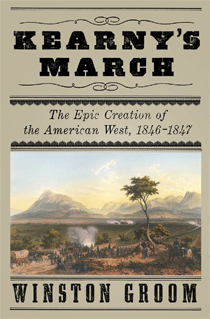By David Madden
Winston Groom conducts his readers upon seven more marches than General Kearny’s, all related to events leading into the Mexican-American War. An historical work obviously written to appeal to the general reader in the tradition of Shelby Foote’s Civil War narrative, Kearny’s March tells vitally related stories that appeal to the emotions, the imagination, and the intellect.
Groom first sets in motion “the most famous man in America,” U.S. Captain John Charles Fremont, “the Pathfinder,” on his third exploratory expedition west across the so-called “Great American Desert” to northern California with a small party, including Indian fighter Kit Carson, “a steely-eyed killer.” His ostensible mission, as a trained engineer and scientist, was to map the trails, but he played an active, controversial role in the Mexican-American War in pursuit of President Polk’s “dream of an America from sea to shining sea.” His mistake was to aspire to lead an uprising in California, and that involved disobeying General Kearny’s orders, which “ultimately exploded into the most sensational court-martial trial of the century”─and being challenged to a duel.
Next, General Kearney set out with an army of two thousand from Fort Leavenworth down the Santa Fe trail a thousand miles to capture the New Mexico territory and to continue another thousand miles southwest into the California territory. Along with “Old Rough and Ready” General Zachary Taylor and military hero “Old Fuss and Feathers” Winfield Scott, General Kearney played a major role in the war with Mexico.
The very image of the Western hero, Colonel Alexander Doniphan led Missouri farm boys on a legendary expedition the equal of Kearny’s in “distance and hardship” south from the Santa Fe Trail. His regiment and Brigadier General John Wool’s force planned to meet and march on Chihuahua “to conquer and occupy that great Mexican state…. The plan was thwarted, however, by a combination of terrain, political duplicity, egotism, misunderstanding, and back stabbing from Washington to Havana and from Vera Cruz to Monterrey, Mexico.
Into those three major narratives of marches and battles, Groom weaves, incrementally, the saga of the Mormon’s migratory march along the Oregon Trail to Salt Lake, a hundred of them playing a voluntary military role in the U.S. Army. Because Brigham Young’s people needed money, Colonel Cooke was able to recruit 500 of them to build a wagon road.
Even as Polk’s dream of manifest destiny was coming true in battles north and south in the great West, the Mormons and the Donner Party were putting into practice, under the most severe conditions, the American Dream of a new life on the new frontier.
Along the same timeline, Groom also traces the Donner Party’s trek along the Oregon Trail across the desert, full of sudden horrors: hostile Indians, fierce wolves, rattlesnakes, dispiriting mirages, ungodly weather. In their “Starved Camp,” “they ate the mules, and then they ate the Indians.” Only a few passed through the snow-bound mountains to Sutter’s Fort near the Pacific Ocean. Edwin Bryant wrote in his diary: “The trip is sort of a magic mirror, and exposes every man’s qualities of heart connected with it, vicious or amiable.” Groom is visionary: “But even the horror of their failure underscores the success of countless others who heralded Polk’s initiative to expand the United States to the Pacific Ocean.”
Out of “the fog of history,” Groom plunges his readers into “the midst of this mazy whipsaw” of events. Sustaining a lively narrative pace and an engaging, often witty, style, Groom, author of six other histories and six novels, including Forrest Gump, moves lucidly and adeptly back and forth from one evolving story to another, enabling the reader to experience something rare─a feeling of myriad-mindedness and a sense of the simultaneity of historical events over a vast landscape in a short time span.
David Madden (ΦBK, University of Tennessee, 1979) is a novelist and resident member of the Epsilon of Tennessee chapter of Phi Beta Kappa.




